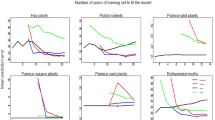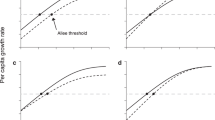Summary
Many models of animal populations show complex yet predictable patterns of density changes under simple and plausible assumptions. Yet one previous attempt to determine the extent and importance of complex dynamics concluded that they were likely only in some laboratory populations, but not in field populations. Ecologists have treated changes more complex than a return to a simple equilibrium, such as the cyclical changes in populations of lynx and voles in the arctic, as special cases. Highly variable populations, such as insects, are usually thought to be driven by unpredictable changes in the weather. Here, we assemble 71 populations counted for over 50 years, and suggest that complex yet predictable population changes are more common than previously thought.
Similar content being viewed by others
References
Bodenheimer, F. S. (1958)Animal Ecology Today. W. Junk, The Hague.
Davidson, J. and Andrewartha, H. G. (1948) Annual Trends in natural populations ofThrips imaginis.J. Anim. Ecol. 17, 193–9.
Elton, C. S. and Nicholson, M. (1942a) Fluctuations in numbers of muskrats (Ondatra zibethicus) in Canada.J. Anim. Ecol. 11, 96–126.
Elton, C. S. and Nicholson, M. (1942b) The ten-year cycle in numbers of the lynx in Canada.J. Anim. Ecol. 11, 215–44.
Elton, C. S. (1942)Voles Mice and Lemmings. Clarendon Press, Oxford.
Finerty, J. P. (1980)The Population Ecology of Cycles in Small Mammals. Yale University Press, New Haven.
Fraser, A. M. (1989) Reconstructing attractors from scalar time series: a comparison of singular system and redundance criteria.Physica D. 34, 391–404.
Fraser, A. M. and Swinney, H. L. (1986) Independent coordinates for strange attractors from mutual independence.Physical Review A 33, 1134–40.
Gilpin, M. E. (1979) Spiral chaos in a predator-prey model.Am. Nat. 113, 306–8.
Hansson, L. (1987) An interpretation of rodent dynamics as due to trophic interactions.Oikos 50, 308–18.
Hansson, L. and Hentonnen, H. (1985) Gradients in density variations of small rodents: the importance of latitude and snow cover.Oecologia 67, 394–402.
Hentonnen, H., Oksanen, T., Jortikka, A. and Haukisalmi, V. (1987) How much do weasels shape microtine cycles in northern Fennoscandian taiga?Oikos 50, 353–65.
Hassell, M. P., Lawton, J. H. and May, R. M. (1976) Patterns of dynamical behaviour in single-species populations.J. Anim. Ecol. 45, 471–86.
MacKenzie, J. M. D. (1952) Fluctuations in the numbers of British tetronids.J. Anim. Ecol. 21, 128–53.
MacLulich, D. A. (1957) The place of chance in population processes.J. Wildl. Mgmt. 21, 293–9.
May, R. M. (1987) Chaos and the dynamics of biological populations.Proc. Roy. Soc. A. 413, 27–44.
Middleton, A. D. (1934) Periodic fluctuations in British game populations.J. Anim. Ecol. 3, 231–49.
Pimm, S. L. (1990)The Balance of Nature? Chicago University Press, Chicago.
Rausch, R. A. and Pearson, A. M. (1972) Notes on the wolverine in Alaska and the Yukon Territory.J. Wildl. Mgmt. 36, 249–68.
Reynolds, C. M. (1979) The heronries census: 1972–1977 population changes and a review.Bird Study 26, 7–12.
Schaffer, W. M. (1985) Can nonlinear dynamics elucidate mechanisms in ecology and epidemiology?IMA J. Math. Appl. Med. Biol. 2, 221–52.
Schaffer, W. M. and Kot, M. (1985) Nearly one dimensional dynamics in a simple epidemic.J. Theor. Biol. 112, 403–27.
Schaffer, W. M. and Kot, M. (1986a) Chaos in Ecological Systems: The coals that Newcastle forgot.Trends in Ecol. Evol. 1, 58–63.
Schaffer, W. M. and Kot, M. (1986b) Differential systems in ecology and epidemiology. InChaos (A. V. Holden, ed.) pp. 158–78. Princeton University Press, Princeton.
Stafford, J. (1971) The heron population of England and Wales.Bird Study 18, 218–21.
Takens, F. (1981) InDynamical Systems and Turbulence (D. A. Rand and L.-S. Young, eds) pp. 366–81. Springer Verlag, New York.
Varley, G. C. (1949) Population changes in German forest.J. Anim. Ecol. 18, 117–22.
Williams, G. R. (1954) Population fluctuations in some northern hemisphere game birds (tetraonidae).J. Anim. Ecol. 23, 1–34.
Author information
Authors and Affiliations
Rights and permissions
About this article
Cite this article
Witteman, G.J., Redfearn, A. & Pimm, S.L. The extent of complex population changes in nature. Evol Ecol 4, 173–183 (1990). https://doi.org/10.1007/BF02270914
Issue Date:
DOI: https://doi.org/10.1007/BF02270914




